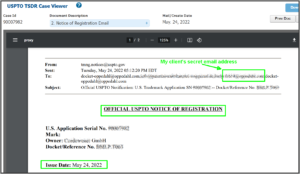
Today, May 24, 2022, the Commissioner for Trademarks published my client’s secret email address to the world. It is not easy to find polite language to describe how I am feeling right now. This is a part of the Trademark Office’s ham-fisted migration from paper registration certificates to electronic registration certificates. I am very disappointed.
By way of background, it will be recalled that on February 6, 2020, the Acting Commissioner for Trademarks released Examination Guide 1-20 which for the first time stated that trademark applicants, even those represented by attorneys, would be required to reveal to the USPTO their personal email addresses. Not only that, the USPTO was going to publish that personal email address to the world, thus available for data mining by scammers and spearphishers.
A couple of days later, one hundred and ninety-nine trademark practitioners wrote to the Acting Commissioner expressing grave concerns about this. The bad thing that was imminent was that on Saturday, February 15, 2020 the Trademark Office was going to change TEAS in a way that would require provision of the applicant’s personal email address even in cases where the applicant had retained counsel. You can see the letter here.
At 4:32 PM on Friday, February 14 (the day before the planned rollout of the new software), the Acting Commissioner blinked. The software got revised and the Examination Guide got revised, and it was no longer going to be required that the applicant would have to reveal his or her personal email address. Instead, it was only required that the email address be one “chosen by” the applicant. The Acting Commissioner eventually responded to the one hundred and ninety-nine trademark practitioners as you can see here. The only corrective action taken by the Trademark Office, unfortunately, was to mask the email address in the “status” tab of TSDR. But the email address continued to be open for data mining in the “documents” tab of TSDR. the applicant email address also continued to be available to data mining in other public-facing databases and public APIs (application programming interfaces).
As I reported in my blog on April 21, 2020, the Acting Commissioner did eventually do the right thing, promising to the Trademark Public Advisory Committee that the Trademark Office would
mask the owner email address field in TEAS and TEASi documents viewable in TSDR. This includes submissions viewable in the documents tab, all application programming interfaces (APIs), and PDF downloads.
But now this promise has been broken. Today the Trademark Office sent out an email message that you can see quoted above, entitled Official USPTO Notice of Registration. The email message should have gotten sent only to me, since I am the attorney of record. But the Trademark Office also sent the email message directly to my client in Europe at my client’s secret email address, which I provided under duress when I filed the patent application in the first place. You can see my client’s secret email address in the green rectangle at the upper right in the quoted email message. (I pixelated it for purposes of the image in this blog article.) The point here is that the Trademark Office then published the email message as a PDF document in TSDR. So now, the spammers and spearphishers of the world have certainly already scraped my client’s secret email address from that PDF document.
I need to give credit where credit is due. The person who tipped me off to this problem is alert reader Lindy M. Herman, a very smart intellectual property lawyer in Orange County, California.
I think the right thing for the Commissioner for Trademarks to do at this point would be to write a personal letter of apology to my client (provided to me, for me to pass along to my client), and to undertake to reimburse all costs incurred by my client in having to change and update the email address.
The same apology and undertaking of cost reimbursement would be appropriate for the other 20837 trademark applicants whose secret email addresses got published today.

Heads up: you did not blur out the trademark’s registration number in the top left corner of the TSDR case viewer screenshot.
The USPTO has already been disclosing the applicant email addresses on notices of abandonment (since at least January of this year) and more recently on Section 8 reminders.
While most clients don’t want to share their email address, I’ve had one or two that actually want me to include it in a way that makes it public. I believe they felt that this might make it easier for potential business partners and customers to contact them. So really, it would be nice if that entry were, once again, an optional entry that could be completed or omitted at the applicant’s discretion.
This reminds me of the “action” in ePCT in which a PCT applicant has the option, if it wishes, of indicating in Patentscope that its invention is available for licensing. This is in fact a searchable field in Patentscope, and is, I think, yet another example of WIPO being applicant-friendly. Yes, if only the USPTO could emulate some of WIPO’s applicant-friendly ways.